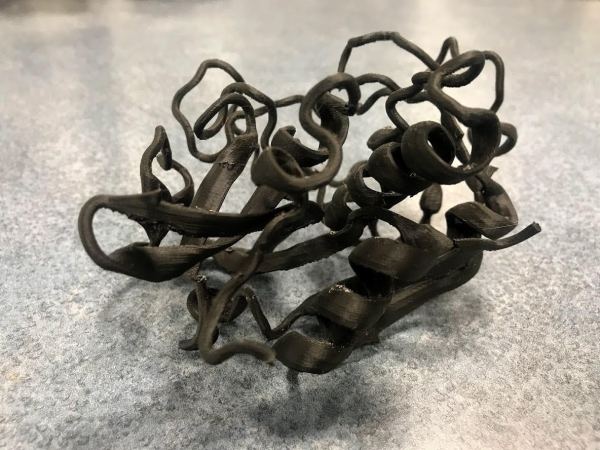
The Himmelfarb Library and the SMHS Office of Diversity and Inclusion will be hosting the National Library of Medicine (NLM) exhibit: Against the Odds: Making a Difference in Global Health.
,br.

The Rotation: A Himmelfarb Library Blog
Resources, tools & health news from GW Himmelfarb Health Sciences Library

The Himmelfarb Library and the SMHS Office of Diversity and Inclusion will be hosting the National Library of Medicine (NLM) exhibit: Against the Odds: Making a Difference in Global Health.
,br.

Our 3D printer has been in use for almost a year, and in that time the Himmelfarb community has printed some incredible 3D models!
3D printing has applications in both medical education and practice. It has impacted everything from patient-specific anatomical models to quicker implant production, and more precise drug creation in the pharmaceutical industry. Researchers have even explored combining 3D printing techniques with human cells to create transplantable organs.
For more information, check out our 3D Printing LibGuide. Stop by the computer workstation to the left of the Himmelfarb entrance to submit your 3D print job today!




[youtube https://www.youtube.com/watch?v=-vgNMin8IuA]
 Bored of the default graphing options on Microsoft Excel? Want to take your data visualizations to the next level?
Bored of the default graphing options on Microsoft Excel? Want to take your data visualizations to the next level?
Tableau is a software program which allows users to create stunning
visualizations of their data. Users can import data in a number of formats (an Excel spreadsheet, for example) and Tableau will help them create graphs and charts that go beyond what they can do in programs like Excel.
There is a free version of the program called Tableau Public if you’re interested in downloading this and giving it a try. For those who work in SMHS, the folks at CASS (Computer and Applications Support Services) recently added Tableau Public to the software center to make it available for you to download on your work computer.
Be sure to explore Tableau Public's gallery of examples including The Health Risk of Where You Live, Ohio, 2017 by Joshua Smith.
 Bring your ideas to life as 3D printed objects!
Bring your ideas to life as 3D printed objects!
Courtesy of a grant from the GW Hospital Women's Board, Himmelfarb Library now has a 3D printer available to faculty, residents, students, and staff of GW's School of Medicine and Health Sciences, School of Nursing, Milken Institute School of Public Health, the GW Medical Faculty Associates, and the GW Hospital.
Use our 3D Printing at Himmelfarb guide to learn about Himmelfarb's 3D printing policies and FAQs, where to find 3D models, and to learn about scholarly uses of 3D printing!
 How do you learn?
How do you learn?
Do you know the twelve cranial nerves (of Christmas)?
 Want to study heart and lung anatomy? Other aspects of human anatomy? Do you want an interactive anatomy atlas on your iPad? Himmelfarb has the Visible Body Anatomy Atlas for you!
Want to study heart and lung anatomy? Other aspects of human anatomy? Do you want an interactive anatomy atlas on your iPad? Himmelfarb has the Visible Body Anatomy Atlas for you!
Visible Body Human Anatomy Atlas provides a new way to study and explore anatomy. This online anatomy atlas allows you to view specific structures and layers from head to toe, rotate anatomical models, and explore systemic and regional anatomy.
Visible Body Human Anatomy Atlas includes 5,000+ medically accurate anatomical structures and was developed by medically trained illustrators and reviewed by anatomists. This atlas allows you to explore human anatomy via multiple approaches: systemic anatomy, regional anatomy, cross sections, senses, and muscle actions.
To install, download the app from an on-campus location (or from off-campus while you have Cisco AnyConnect turned ‘on’). To maintain access to the app, open your Visible Body app while on-campus or while off-campus and connected via Cisco AnyConnect at least every 150 days.

How do you teach? If you’re interested in adding innovation to your instruction, check out online modules made available by GW faculty!
Online teaching materials and modules serve as great teaching tools in medical education. GW’s SMHS and CNHS faculty have published these tools in the AAMC’s MedEdPortal, which houses open-source materials. The teaching materials provide access to multiple documents, including powerpoints, guides, and surveys.
Some of the topics covered by the modules are newborn care, OB/GYN, navigating the wards and more!
Check out the modules here!
 Want to compare health data between states?
Want to compare health data between states?
 Are you revising your curriculum? Redesigning sessions to include more active learning? Flipping the classroom?
Are you revising your curriculum? Redesigning sessions to include more active learning? Flipping the classroom?
Himmelfarb Library has created an Active Learning Resources Research Guide to support faculty. This guide will help faculty identify tools and resources to support their efforts and includes information on:
Image: Ben-Avraham, Y. (2011). Solving jigsaw puzzle [Image]. Retrieved from http://www.flickr.com/photos/epublicist/8718123610/